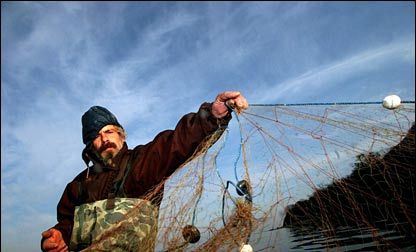美国最致命的五项职业
爱思英语编者按:你可能已经读过有关美国华尔街从业人员由于金融风暴、经济萧条及抵押赎回权、毕生积蓄的丧失而希望对华尔街进行报复的新闻报道。虽然那几乎让金融业保险业的从业人员等陷于极其危险的境地,但实际上在其他行业你有更加更加大的可能被“谋杀”。
You may have read news reports saying that America's Main Streeters want revenge on Wall Street for the financial meltdown and recession and mortgage foreclosures and lost life savings. That hardly makes fields like finance and insurance hazardous to be in, though. You're much, much likelier to get killed in other lines of work.
Recently released Department of Labor data show that fishermen (and fisherwomen) and other workers in fishing-related professions were the most likely to die on the job in 2008. Of 39,000 fishing workers in the nation, 50 were killed, a rate of 128.9 per 100,000 full-time workers. Rough seas, unpredictable deadly weather and isolation during emergencies all make the job more unsafe than any other. It's no wonder that the industry's perils have given rise to a popular documentary TV series, Deadliest Catch, and a best-selling book and hit Hollywood film, The Perfect Storm.

The Bureau of Labor Statistics' National Census of Fatal Occupation Injuries counted 5,071 fatal work injuries in 2008. That was 7.6% fewer than in 2007, and 13% less than in 2006, which marked a five-year high for workplace fatalities. That's the good news in the numbers.
Logging workers and aircraft pilots have the second and third deadliest jobs. Eighty-two loggers died last year from work injuries, some of them caused by falling trees and malfunctioning cutting equipment. Ninety aircraft pilots died in crashes and other accidents.
Transportation incidents are the most common cause of fatalities, overall. This year, 40.5% of the worker deaths, 2,053 of them, were transportation-related. More than half were highway incidents, which have been the most common killer every year since the Labor Department started tracking workplace fatalities in 1992. Equipment- and objects-related injuries came in a distant second, accounting for 923 fatalities, or 18.2%.
While putting in 57% of the total hours worked by Americans, men made up 92.7% of the workplace fatalities. The relatively few women killed were more likely to die from on-the-job homicide, though: 26% of the female workplace deaths were murders, compared with only 9% of the male deaths. "For several occupations with high fatality rates, including truck drivers and farmers, and several industries with high fatality rates, like construction and mining, men constitute a much larger part of the total employment," Stephen Pegula, an economist with the Bureau of Labor Statistics, explains. "In addition, women are often employed in occupations and industries, like trade and leisure/hospitality, where homicides are more prevalent."
The construction industry suffered the largest number of deaths. Its fatality rate per 100,000 full-time workers was only 9.6, less than a 10th of that of people in fishing, but that added up to 969 deaths in 2008, no less than 19.1% of all U.S. workplace fatalities.
What about those Wall Streeters? People in finance and insurance actually had the lowest fatality rate of any occupation -- 0.3 deaths per 100,000 full-time workers, or just 24 people across the nation. 更多信息请访问:http://www.engbus.cn/
Top 5 America's Deadliest
Jobs1. Fishers and Related Fishing Workers
The Job: Capture aquatic animals in large quantities.
The Dangers: Extreme weather, large equipment, drowning
The Fatality Rate*: 128.9
Total Fatalities in 2008: 50
*per 100,000 full-time equivalent workers
2. Logging Workers
The Job: Cut down and trim trees for sale and transport.
The Dangers: Falling trees, cutting equipment, difficult terrain
The Fatality Rate*: 115.7
Total Fatalities in 2008: 82
*per 100,000 full-time equivalent workers
3. Aircraft Pilots and Flight Engineers
The Job: Operate planes and helicopters.
The Dangers: Testing equipment, emergency response, crashes
The Fatality Rate*: 72.4
Total Fatalities in 2008: 90
*per 100,000 full-time equivalent workers
4. Structural Iron and Steel Workers
The Job: Mold, set and handle metal construction materials.
The Dangers: Heights, heavy materials, welding
The Fatality Rate*: 46.4
Total Fatalities in 2008: 36
*per 100,000 full-time equivalent workers
5. Farmers and Ranchers
The Job: Grow and cultivate livestock and crops.
The Dangers: Heavy machinery.
The Fatality Rate*: 39.5
Total Fatalities in 2008: 317
*per 100,000 full-time equivalent workers